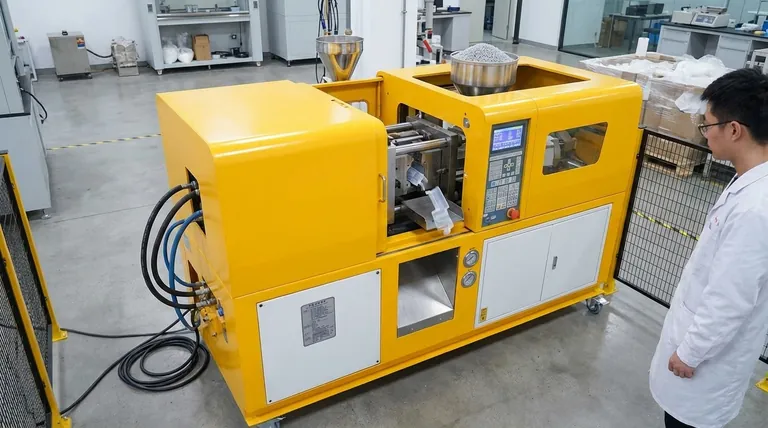In manufacturing, molding is a core technique for shaping pliable raw materials into a desired, solid form using a rigid frame known as a mold. The process typically involves applying heat and pressure to a material like plastic or metal, forcing it into a specially designed cavity. Once inside, the material cools and hardens, perfectly replicating the mold's intricate shape.
Molding is fundamentally about transformation. It takes a formless raw material and, through the controlled application of heat and pressure within a defined cavity, forces it to adopt a specific, repeatable, and often complex shape.

The Fundamental Principles of Molding
To truly understand molding, you must look at its four core components: the mold, the material, the application of force, and the solidification process. Each element plays a critical role in the final outcome.
The Mold (The Matrix)
The mold is the heart of the process. It's a hollow, rigid block—often made from hardened steel—that contains the negative space, or cavity, of the part you want to create.
The quality and precision of the mold directly dictate the quality and precision of every part produced. It is the blueprint made physical.
The Raw Material (The Charge)
Molding works with materials that can be made pliable, most commonly plastics, but also metals, glass, and ceramics. This raw material, often in the form of pellets or liquid, is the "charge" that will be transformed.
The choice of material is dictated by the final product's requirements, such as strength, flexibility, or heat resistance.
The Application of Force and Heat
Heat is applied to the raw material to make it molten and flow easily. Pressure is then used to inject or force this pliable material into every crevice and detail of the mold's cavity.
This combination ensures the final part is fully formed and free of voids, capturing even the most subtle design features.
The Solidification Process
Once the cavity is filled, the material must harden to lock in its new shape. This happens in one of two ways:
- Cooling: For materials like thermoplastics, the mold is cooled, causing the material to solidify.
- Curing: For other materials, like thermosetting plastics or rubber, a chemical reaction known as vulcanization or curing takes place, often aided by continued heat, which causes the material to harden irreversibly.
Understanding the Trade-offs
While powerful, molding is not a universal solution. Understanding its inherent trade-offs is critical for making sound technical and business decisions.
High Initial Tooling Costs
The primary barrier to entry is the cost of creating the mold itself. Designing, engineering, and machining a high-precision, durable steel mold is a significant upfront investment.
This expense makes molding unsuitable for very small production runs or one-off prototypes.
Long Lead Times for Mold Creation
The process of creating that initial mold is not only expensive but also time-consuming. It can take weeks or even months to go from a final design to a production-ready tool.
Design Rigidity
Once a mold is machined from a block of steel, making significant changes to the part design is extremely difficult and costly. The design must be thoroughly validated before the tool is made.
Minor adjustments might be possible, but a complete redesign often means starting over with a new mold.
Making the Right Choice for Your Goal
Molding is a strategic choice best suited for specific production goals. Use these points as your guide.
- If your primary focus is high-volume production: Molding is unparalleled for creating thousands or millions of identical parts with extremely low per-unit costs.
- If your primary focus is complex part geometry: This technique excels at producing intricate shapes with integrated features, which can reduce the need for secondary assembly operations.
- If your primary focus is high precision and repeatability: Molding ensures that every part produced is a near-perfect clone of the last, which is critical for quality control and automated assembly.
Ultimately, understanding these principles empowers you to recognize when molding is the most effective strategy to bring a physical product from concept to reality.
Summary Table:
| Aspect | Key Takeaway |
|---|---|
| Core Principle | Shaping pliable materials using a rigid mold, heat, and pressure. |
| Best For | High-volume production, complex geometries, and high repeatability. |
| Primary Trade-off | High initial mold cost and long lead times, unsuitable for prototypes. |
| Key Components | Mold (cavity), Raw Material, Application of Force/Heat, Solidification. |
Ready to bring your high-volume production to life?
At KINTEK, we specialize in providing the advanced lab equipment and consumables necessary for perfecting your molding processes. Whether you're developing new materials or ensuring quality control, our solutions help you achieve the precision and repeatability that molding demands.
Contact our experts today to discuss how we can support your laboratory's specific needs in material testing and process development.
Visual Guide

Related Products
- Small Injection Molding Machine for Lab Use
- Double Plate Heating Press Mold for Lab
- Manual High Temperature Heated Hydraulic Press Machine with Heated Plates for Lab
- Lab Plastic PVC Calender Stretch Film Casting Machine for Film Testing
- Automatic Heated Hydraulic Press Machine with Heated Plates for Laboratory Hot Press 25T 30T 50T
People Also Ask
- What is a positive of injection moulding? Achieve High-Volume Production with Unmatched Efficiency
- What is the manufacturing process of rubber molding? Injection, Compression, or Transfer Molding?
- What is the application of injection moulding machine? Powering Mass Production for Complex Parts
- What can you make with an injection moulding machine? Mass-Produce High-Quality Plastic Parts Efficiently
- What is short capacity of injection Moulding machine? Optimize Your Shot Size for Flawless Parts



















